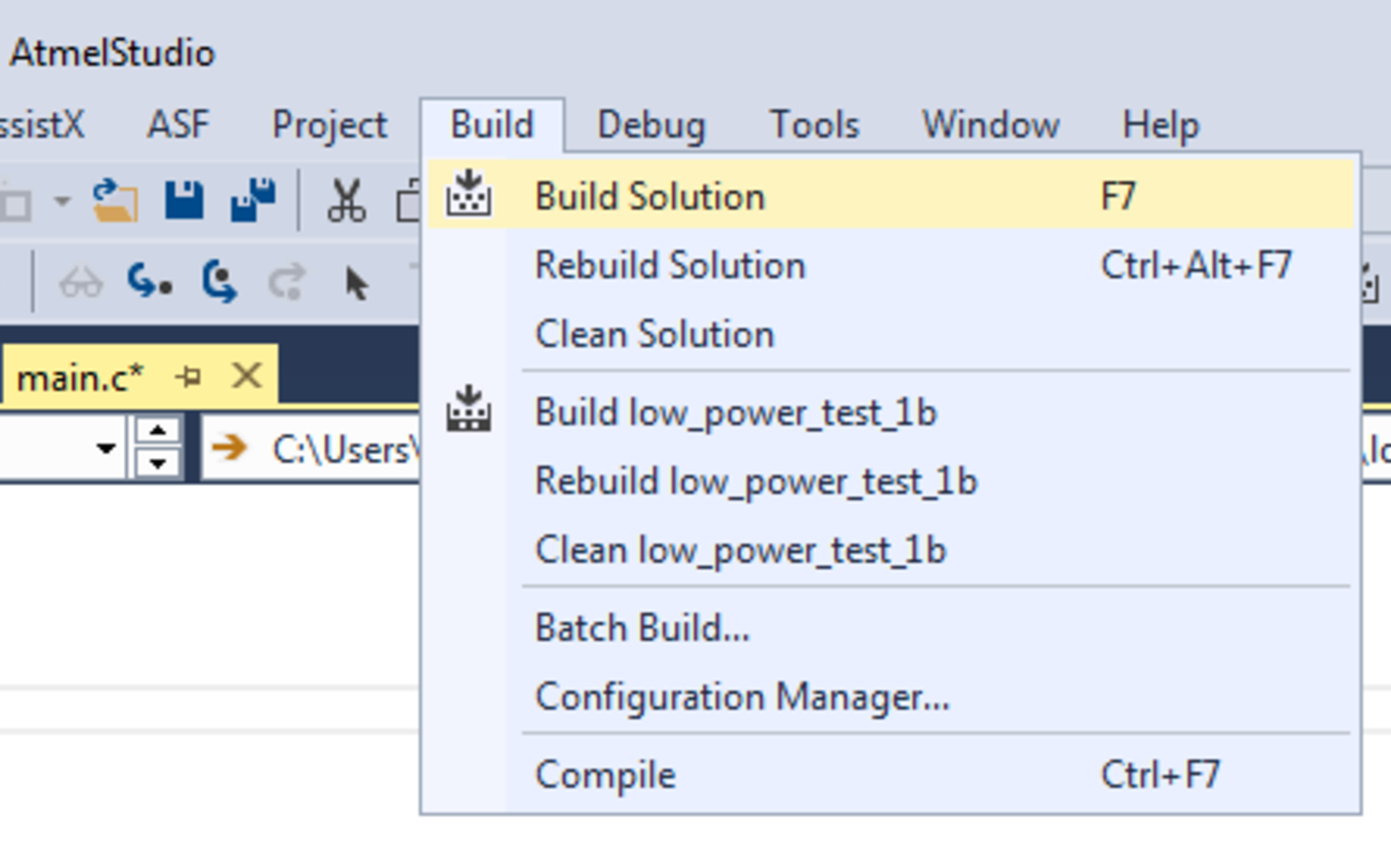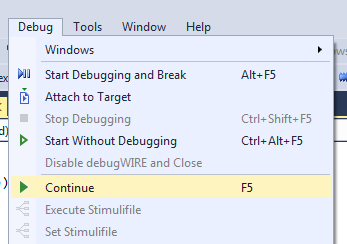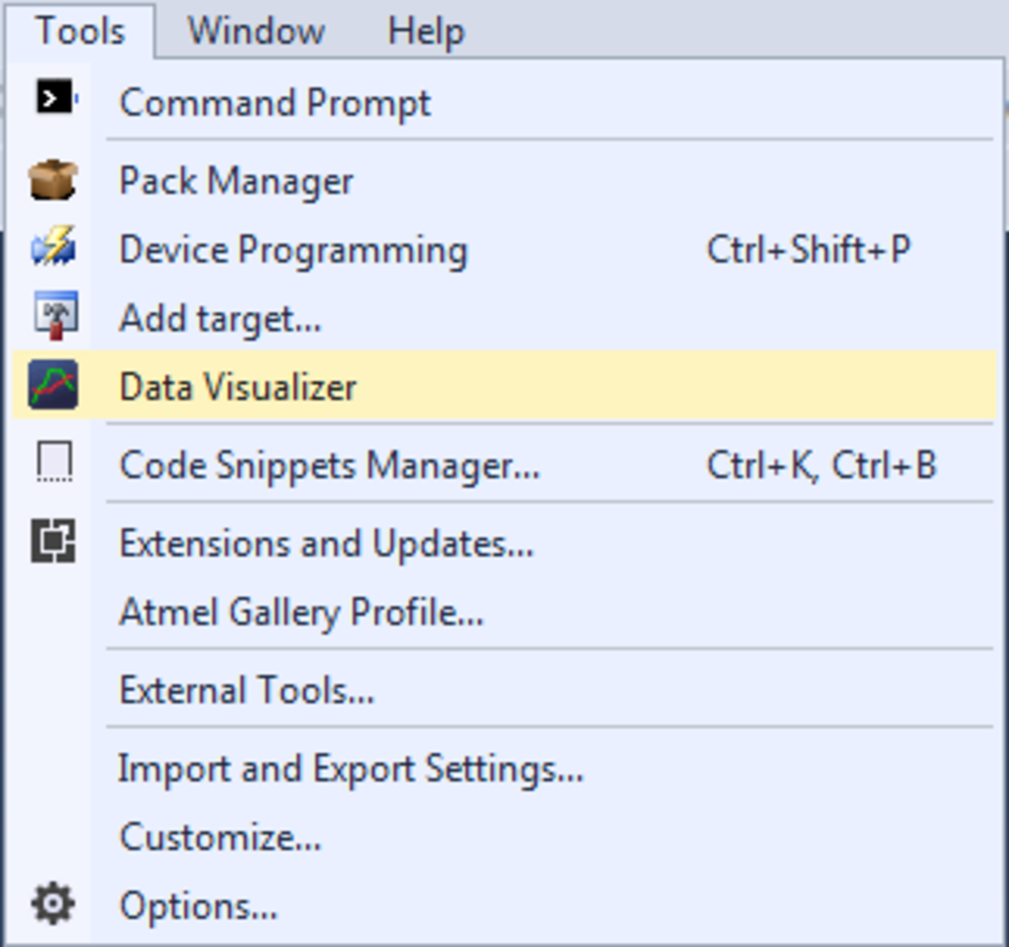6.5 Dashboard Example Code
To demonstrate how to use the Dashboard module, an example with a Night mode switch will be used. An ATmega256RFR2 Xplained Pro with an I/O1 Xplained Pro extension is suitable as target hardware. The I/O1 extension board features a light sensor that can be used to detect whether it is night or day. This information can be used, for example, to switch a lamp on when the surroundings turn dark.
- Host computer with Atmel Studio 7 or later installed (Data Visualizer is included)
- ATmega256RFR2 Xplained Pro kit
- I/O1 Xplained Pro extension
- I/O1 Xplained Pro extension connected to ATmega256RFR2 Xplained Pro EXT1 connector
- USB cable connected from host computer to ATmega256RFR2 Xplained Pro

The ATmega256RFR2 target on the Xplained Pro must be programmed with code that implements the Night mode switch.
- Make a new project in Atmel Studio (File → New → Project → GCC C Executable Project)
- Replace the content of the automatically generated main.c file with the code below
#include <avr/io.h>
#include <avr/interrupt.h>
union u_double{
double dbl;
char data[8];
};
uint16_t adc_value = 0;
uint8_t nightmode_threshold;
uint8_t nightmode_active = 0;
union u_double cdc_received_data;
uint8_t cdc_read_index=0;
ISR (USART1_RX_vect){
// A byte is received on the CDC UART, MSB first
cdc_received_data.data[cdc_read_index] = UDR1 & 0xFF;
if (7 == cdc_read_index){
// A complete double value is received
nightmode_threshold = (uint8_t) cdc_received_data.dbl;
cdc_read_index = 0;
}
else {
cdc_read_index++;
}
}
void adc_init(void){
// Internal 1.5V reference, ADC0 as single ended input
ADMUX = (1 << REFS1);
// Enable the ADC,
ADCSRA |= (1<<ADEN);
// Check that the reference is OK
while (0x00 == (ADCSRB & (1 << REFOK)));
}
uint16_t adc_sample(void){
// Trigger an ADC conversion
ADCSRA |= (1<<ADSC);
// Wait for conversion to finish
while (0x00 == (ADCSRA & (1 << ADIF)));
// Clear the interrupt flag
ADCSRA |= (1 << ADIF);
return (ADC);
}
void spi_init(void){
// Slave select (PB0), MOSI (PB2) and SCK (PB1) as output
DDRB |= (1<<PINB0) | (1<<PINB2) | (1<<PINB1);
//Slave select high (inactive)
PORTB |= (1<<PINB0);
// Master mode, enable SPI module. Clock polarity and phase is kept at default (Rising edge is leading edge and sample on leading edge)
SPCR = (1<<SPE) | (1<<MSTR);
}
void spi_send(uint8_t data){
// Slave select low
PORTB &= ~(1<<PINB0);
// Write data to shift register
SPDR = data;
// Wait for the transmission to complete
while (0x00 == (SPSR & (1<<SPIF)));
// Slave select high
PORTB |= (1<<PINB0);
}
void cdc_init(void){
// Baud rate 9600 based on 8 MHz CPU clock
UBRR1 = 51;
// Enable the transmitter and receiver, 8 bit character size, receive interrupts enabled
UCSR1B = (1<<RXEN1) | (1<<TXEN1) | (1<<RXCIE1);
}
void cdc_send(const char data){
// Wait for transmitter to be ready for more data
while (0x00 == (UCSR1A & (1<<UDRE1)));
// Send the data
UDR1 = data;
}
int main(void){
adc_init();
spi_init();
cdc_init();
// Interrupts on
sei();
while (1){
adc_value = adc_sample();
// Send the ADC value over SPI to the host
// Only the 8 lower bits contain useful data
spi_send(adc_value & 0xFF);
// higher adc value == less light
if (adc_value > nightmode_threshold){
if (0x00 == nightmode_active){
// Changing from nightmode inactive to active
nightmode_active = 0x01;
}
} else {
if (0x01 == nightmode_active){
// Changing from nightmode active to inactive
nightmode_active = 0x00;
}
}
cdc_send(nightmode_active);
}
}The code samples the ADC continuously and sends the data over the SPI interface to the EDBG (Embedded Debugger) on the ATmega256RFR2 Xplained Pro board. The EDBG then sends the SPI data over DGI to the host computer. The ATmega256RFR2 ADC is 10-bit but only the lower 8 bits contain useful data in this example.
In addition, the code sets up the CDC USART and sends the state of the Night mode switch as a single byte. The received data on the CDC USART is parsed as a double value and is used as threshold for the Night mode switch.

- Open the project properties (right click the project in the Solution Explorer and select Properties)
- On the Tool tab, select the appropriate tool and interface



